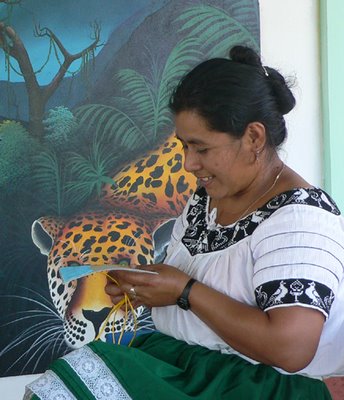My weekend began with a three hour bus ride to Dangriga, with the same punta rock CD played over and over. In a weekend filled with the fast drum beating pulse of punta music, I heard everything from traditional Garifuna cadences to a rendition of The Farmer in the Dell blaring out of someone's balcony. Dangriga, the cultural center of the Garifuna people, is were I celebrated Garifuna Settlement Day on the 19th.
Also known as the Garinagu (plural) or Black Caribs, the people trace their history back to a group of African slaves who escaped two ship-wrecked Spanish slave ships near St. Vincent in 1635. St. Vincent was invaded by the British and the Garifuna were deported to Roata¡n in 1796 (an island off the coast of Honduras). The Garifuna fled Honduras in 1832 after a failed attempt to overthrow the Republican government. This mass migration to Belize is what the Garinfuna now celebrate on November19.
The party began early on Saturday with live music in the street and people all around. At night I went to PuntaFest with the group of Volunteers, too early apparently. The crowd was small and it sounded like the action outside the tent was much more exciting. Later that night we returned to a full crowd and danced the night away. To punta dance all you have to do is shake your hips profusely. I got a few hours of sleep, but the music and dancing never stopped.
At six in the morning we gathered around the bridge to watch a re-enactment. Three boats, decorated with palm leaves, appeared on the horizon of the sea and the drum beats grew louder as they paddled closer to shore. The Garifuna, in traditional dress carried cassava, plaintains, and other greens as they danced to drums. Once the boats landed the Garifuna started a procession to the Catholic church. The Garifuna practice of Catholocism is fused with their African beliefs, most evident to me was the lively music. The entire service was spoken in Garifuna. After mass I re-connected with the Volunteers enjoying more punta rock from a jukebox, where we also met a Garifuna woman with albino rats ( Jack and Jill) clinging to her shoulders as she danced.
In typical Belize fashion the parade started a few hours later than scheduled and at the end everyone started dancing behind the last float. After burning so much energy I found some traditional food being served under a tent. The conch soup with ground food was good. Again the festivities were as lively as the night before. Garifuna Settlement Day was a great time for me and I can still hear the rythm ringing in my ears. But what I really noticed was the cultural pride in the Garifuna and wanting to share that happiness with visitors.



